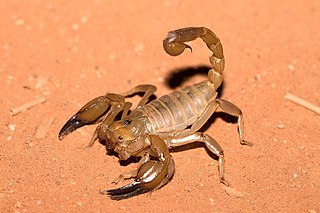
Pseudoscorpions, also known as false scorpions or book scorpions, are small, scorpion-like arachnids belonging to the order Pseudoscorpiones, also known as Pseudoscorpionida or Chelonethida.

Urodacus is a genus of scorpion belonging to the family Urodacidae. It was described by German naturalist Wilhelm Peters in 1861. The type species is U. novaehollandiae. Its species are native to Australia, and dig burrows. The genus was placed in its own family in 2000. Before this, the group had been a subfamily Urodacinae within the family Scorpionidae. There are likely many undescribed, cryptic species within the genus.
Austrochernes is a genus of pseudoscorpions in the subfamily Chernetinae, first described by Max Beier in 1932. Species of this genus are found in mainland Australia and New Guinea. The Australian Faunal Directory decisions for synonymy are based on a 2018 paper by Mark Harvey.
Austrochernes cruciatus is a species of pseudoscorpion in the subfamily Chernetinae. It was first described as Troglochernes cruciatus in 2007 by Erich Volschenk.
Indohya is a genus of pseudoscorpions in the Hyidae family. It was described in 1974 by Austrian arachnologist Max Beier.
Indohya humphreysi is a species of pseudoscorpion in the Hyidae family. It is endemic to Australia. It was described in 1993 by Australian arachnologist Mark Harvey.
Indohya panops is a species of pseudoscorpion in the Hyidae family. It is endemic to Australia. It was described in 1993 by Australian arachnologist Mark Harvey.
Indohya typhlops is a species of pseudoscorpion in the Hyidae family. It is endemic to Australia. It was described in 1993 by Australian arachnologist Mark Harvey.
Indohya damocles is a species of pseudoscorpion in the Hyidae family. It is endemic to Australia. It was described in 2007 by arachnologists Mark Harvey and Erich Volschenk.
Indohya gollum is a species of pseudoscorpion in the Hyidae family. It is endemic to Australia. It was described in 2007 by arachnologists Mark Harvey and Erich Volschenk.
Indohya napierensis is a species of pseudoscorpion in the Hyidae family. It is endemic to Australia. It was described in 2007 by arachnologists Mark Harvey and Erich Volschenk.
Anysrius brochus is a species of pseudoscorpion in the Hyidae family. It is endemic to Australia. It was described in 1998 by Australian arachnologist Mark Harvey. The specific epithet brochus refers to the cheliceral teeth of the male.
Anysrius chamberlini is a species of pseudoscorpion in the Hyidae family. It is endemic to Australia. It was described in 1998 by Australian arachnologist Mark Harvey. The specific epithet chamberlini honours American arachnologist Joseph Conrad Chamberlin.
Ideoblothrus descartes is a species of pseudoscorpion in the Syarinidae family. It is endemic to Australia. It was described in 1991 by Australian arachnologists Mark Harvey and Karen Edward. The specific epithet descartes refers to the type locality.
Ideoblothrus westi is a species of pseudoscorpion in the Syarinidae family. It is endemic to Australia. It was described in 1991 by Australian arachnologists Mark Harvey and Karen Edward. The specific epithet westi honours Paul West, collector of the holotype.
Ideoblothrus pisolitus is a species of pseudoscorpion in the Syarinidae family. It is endemic to Australia. It was described in 1991 by Australian arachnologists Mark Harvey and Karen Edward. The specific epithet pisolitus refers to the pisolitic geology of the type locality.
Austrochernes omorgus is a species of pseudoscorpion in the Chernetidae family. It is endemic to Australia. It was described in 2007 by arachnologists Mark Harvey and Erich Volschenk. The specific epithet omorgus refers to the beetle with which the holotype was associated.
Austrochernes dewae is a species of pseudoscorpion in the Chernetidae family. It is endemic to Australia. It was described in 1967 by Austrian arachnologist Max Beier.
Austrochernes guanophilus is a species of pseudoscorpion in the Chernetidae family. It is endemic to Australia. It was described in 1967 by Austrian arachnologist Max Beier.
Satrapanus is a monotypic genus of pseudoscorpions in the Chernetidae family. It is endemic to Australia's Lord Howe Island in the Tasman Sea. It was described in 2007 by Australian arachnologists Mark Harvey and Erich Volschenk. The generic epithet comes from the Latin satrapa with reference to the pseudoscorpion being the only known species of the genus on the island.

